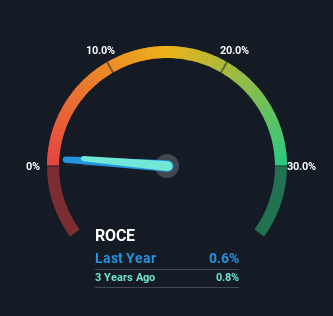Universus Photo Imagings (NSE:UNIVPHOTO) Has Some Difficulty Using Its Capital Effectively
If we're looking to avoid a business that is in decline, what are the trends that can warn us ahead of time? Businesses in decline often have two underlying trends, firstly, a declining return on capital employed (ROCE) and a declining base of capital employed. This indicates the company is producing less profit from its investments and its total assets are decreasing. And from a first read, things don't look too good at Universus Photo Imagings (NSE:UNIVPHOTO), so let's see why.
Return On Capital Employed (ROCE): What Is It?
Just to clarify if you're unsure, ROCE is a metric for evaluating how much pre-tax income (in percentage terms) a company earns on the capital invested in its business. The formula for this calculation on Universus Photo Imagings is:
Return on Capital Employed = Earnings Before Interest and Tax (EBIT) ÷ (Total Assets - Current Liabilities)
0.006 = ₹63m ÷ (₹11b - ₹23m) (Based on the trailing twelve months to March 2023).
So, Universus Photo Imagings has an ROCE of 0.6%. In absolute terms, that's a low return and it also under-performs the Chemicals industry average of 15%.
View our latest analysis for Universus Photo Imagings

Historical performance is a great place to start when researching a stock so above you can see the gauge for Universus Photo Imagings' ROCE against it's prior returns. If you'd like to look at how Universus Photo Imagings has performed in the past in other metrics, you can view this free graph of past earnings, revenue and cash flow.
What Can We Tell From Universus Photo Imagings' ROCE Trend?
We are a bit worried about the trend of returns on capital at Universus Photo Imagings. To be more specific, the ROCE was 0.8% three years ago, but since then it has dropped noticeably. Meanwhile, capital employed in the business has stayed roughly the flat over the period. Since returns are falling and the business has the same amount of assets employed, this can suggest it's a mature business that hasn't had much growth in the last three years. If these trends continue, we wouldn't expect Universus Photo Imagings to turn into a multi-bagger.
The Key Takeaway
In the end, the trend of lower returns on the same amount of capital isn't typically an indication that we're looking at a growth stock. Yet despite these poor fundamentals, the stock has gained a huge 387% over the last three years, so investors appear very optimistic. In any case, the current underlying trends don't bode well for long term performance so unless they reverse, we'd start looking elsewhere.
On a separate note, we've found 1 warning sign for Universus Photo Imagings you'll probably want to know about.
While Universus Photo Imagings may not currently earn the highest returns, we've compiled a list of companies that currently earn more than 25% return on equity. Check out this free list here.
New: AI Stock Screener & Alerts
Our new AI Stock Screener scans the market every day to uncover opportunities.
• Dividend Powerhouses (3%+ Yield)
• Undervalued Small Caps with Insider Buying
• High growth Tech and AI Companies
Or build your own from over 50 metrics.
Have feedback on this article? Concerned about the content? Get in touch with us directly. Alternatively, email editorial-team (at) simplywallst.com.
This article by Simply Wall St is general in nature. We provide commentary based on historical data and analyst forecasts only using an unbiased methodology and our articles are not intended to be financial advice. It does not constitute a recommendation to buy or sell any stock, and does not take account of your objectives, or your financial situation. We aim to bring you long-term focused analysis driven by fundamental data. Note that our analysis may not factor in the latest price-sensitive company announcements or qualitative material. Simply Wall St has no position in any stocks mentioned.
About NSEI:UNIVPHOTO
Universus Photo Imagings
Manufactures, trades, and sells photographic and other imaging products.
Flawless balance sheet and good value.
Market Insights
Community Narratives




